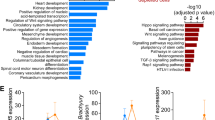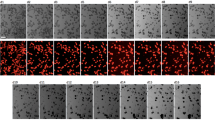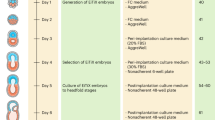Abstract
The potential therapeutic use of embryonic stem cells (ESCs) has gathered the attention of the scientific and medical communities recently. We report that in addition to their unique capacity to populate defective cardiac tissues, ESCs secrete factors that correct gene expression profiles in the defective neighboring cells. Id (inhibitor of DNA binding) gene knockout (KO) mouse embryos die at midgestation because of multiple cardiac defects, but injection of ESCs into preimplantation Id KO embryos prevents these defects and corrects gene expression profiles throughout the heart. ESCs injected into expectant mothers only partially rescue cardiac defects in the Id KO embryos. Two secreted factors are implicated in the rescue process: insulin-like growth factor I accounts for the long-range action of the ESCs, and Wnt5a, a short-range factor, corrects gene expression profiles in the Id KO hearts. Future studies are discussed.
This is a preview of subscription content, access via your institution
Access options
Subscribe to this journal
Receive 12 print issues and online access
$209.00 per year
only $17.42 per issue
Buy this article
- Purchase on Springer Link
- Instant access to full article PDF
Prices may be subject to local taxes which are calculated during checkout
Similar content being viewed by others
References
Davani S et al. (2004) Can stem cells mend a broken heart? Cardiovasc Res 65: 305–316
Mayhall EA et al. (2004) The clinical potential of stem cells. Curr Opin Cell Biol 16: 713–720
Caspi O and Gepstein L (2004) Potential applications of human embryonic stem cell-derived cardiomyocytes. Ann N Y Acad Sci 1015: 285–298
Fraidenraich D et al. (2004) Rescue of cardiac defects in Id knockout embryos by injection of embryonic stem cells. Science 306: 247–252
Ruzinova MB and Benezra R (2003) Id proteins in development, cell cycle and cancer. Trends Cell Biol 13: 410–418
Jen Y et al. (1996) Expression patterns of Id1, Id2, and Id3 are highly related but distinct from that of Id4 during mouse embryogenesis. Dev Dyn 207: 235–252
Jen Y et al. (1997) Each member of the Id gene family exhibits a unique expression pattern in mouse gastrulation and neurogenesis. Dev Dyn 208: 92–106
Reiss K et al. (1996) Overexpression of insulin-like growth factor-1 in the heart is coupled with myocyte proliferation in transgenic mice. Proc Natl Acad Sci USA 93: 8630–8635
Adamo M et al. (1989) Insulin-like growth factor I messenger ribonucleic acids with alternative 5'-untranslated regions are differentially expressed during development of the rat. Endocrinology 124: 2737–2744
Liu JP et al. (1993) Mice carrying null mutations of the genes encoding insulin-like growth factor I (Igf-1) and type 1 IGF receptor (Igf1r). Cell 75: 59–72
Cadigan KM and Nusse R (1997) Wnt signaling: a common theme in animal development. Genes Dev 11: 3286–3305
Schneider VA and Mercola M (2001) Wnt antagonism initiates cardiogenesis in Xenopus laevis. Genes Dev 15: 304–315
Oishi I et al. (2003) The receptor tyrosine kinase Ror2 is involved in non-canonical Wnt5a/JNK signalling pathway. Genes Cells 8: 645–654
Acknowledgements
We thank E Stillwell and EE Romero for performing the experiments with chimeras, K Manova for assistance with the tissue histology, and CT Basson for the echocardiography studies and discussion. D Fraidenraich and R Benezra are supported by grants from the National Institutes of Health.
Author information
Authors and Affiliations
Corresponding author
Ethics declarations
Competing interests
The authors declare no competing financial interests.
Rights and permissions
About this article
Cite this article
Fraidenraich, D., Benezra, R. Embryonic stem cells prevent developmental cardiac defects in mice. Nat Rev Cardiol 3 (Suppl 1), S14–S17 (2006). https://doi.org/10.1038/ncpcardio0402
Received:
Accepted:
Issue Date:
DOI: https://doi.org/10.1038/ncpcardio0402
This article is cited by
-
Inhibitor of DNA binding in heart development and cardiovascular diseases
Cell Communication and Signaling (2019)
-
Hematopoietic Id Deletion Triggers Endomyocardial Fibrotic and Vascular Defects in the Adult Heart
Scientific Reports (2017)
-
Labeling human embryonic stem-cell-derived cardiomyocytes for tracking with MR imaging
Pediatric Radiology (2011)
-
Injection of Wild Type Embryonic Stem Cells into Mst1 Transgenic Blastocysts Prevents Adult-Onset Cardiomyopathy
Stem Cell Reviews and Reports (2011)
-
Rescue of Developmental Defects by Blastocyst Stem Cell Injection: Towards Elucidation of Neomorphic Corrective Pathways
Journal of Cardiovascular Translational Research (2010)



